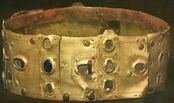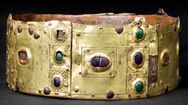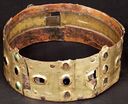Recreating St. Erik's Funerary Crown: Difference between revisions
| Line 21: | Line 21: | ||
I will recreate it using a backing of 22 to 24 gauge copper sheet, with the over plaques being made of 24 to 26 gauge silver sheet. I will do a few experiments in copper to see what I like better and what will hold up better over time. | I will recreate it using a backing of 22 to 24 gauge copper sheet, with the over plaques being made of 24 to 26 gauge silver sheet. I will do a few experiments in copper to see what I like better and what will hold up better over time. | ||
In period, one would pour an ingot of copper or silver and pound it until it was very thin to make the sheeting. I am not that person. My joints would fail and my arm would fall off. Let us pretend, then, that I dropped my ingots at the local blacksmiths with whom I traded eggs and fat coneys to do this work for me. | |||
I will attempt to add some gold details using a “burngilding” technique – something akin, I believe, to Keum Boo, the ancient Korean technique of fusing gold foil to silver. | I will attempt to add some gold details using a “burngilding” technique – something akin, I believe, to Keum Boo, the ancient Korean technique of fusing gold foil to silver. | ||
Latest revision as of 17:44, 3 January 2025
At Winter Coronation/12th Night 2025 Their Majesties Valentine and Brocc created the Royal Artisans of Caid. The purpose of this group is to allow a small group of artisans, who have not yet been recognized as laurels, to showcase the projects they are working on.
This page chronicles THL Megan de Barri's project to recreate the funerary crown of St. Erik of Sweden. Currently the oldest surviving medieval crown, the Krona of St. Erik is housed at the Uppsula Cathedral in Uppsula, Sweden.
St. Erik's Funerary Crown
Erik the I of Sweden, as legend tells it, was fairly chosen to be the king of Sweden, and ascended the throne in 1155 or 1156. He came to an untimely demise in 1160 at the hands of a Danish claimant to the throne. His remains have rested in reliquary since at least 1257.
Since facts on the krona itself are scarce, I contacted the museum at the Uppsula Cathedral and was fortunate to receive information directly from them.
The krona is made of two layers of copper sheet. The outer layer has been “burngilded” with gold. The crown has eight short points and is decorated with engraved designs set with blue, red and green glass. Small holes around the base of the band indicate that a cap was sewn into it for the comfort of the wearer.
According to Museum lady, there is debate on if there were fleurs or something atop the points that were cut off, or if that's the way is was originally. There is, apparently, a little evidence that something may have been broken off.
The crown was broken into 15 pieces has been repaired at least twice. Once sometime during the Middle Ages, and again in 16th or 17th century where the copper bands were added.
Project Specifications
I will recreate this crown but redesign it to be an SCA acceptable six point Court Baronial coronet.
I will recreate it using a backing of 22 to 24 gauge copper sheet, with the over plaques being made of 24 to 26 gauge silver sheet. I will do a few experiments in copper to see what I like better and what will hold up better over time.
In period, one would pour an ingot of copper or silver and pound it until it was very thin to make the sheeting. I am not that person. My joints would fail and my arm would fall off. Let us pretend, then, that I dropped my ingots at the local blacksmiths with whom I traded eggs and fat coneys to do this work for me.
I will attempt to add some gold details using a “burngilding” technique – something akin, I believe, to Keum Boo, the ancient Korean technique of fusing gold foil to silver.
It is my intention to use cut stone cabochons for the decoration instead of glass.


